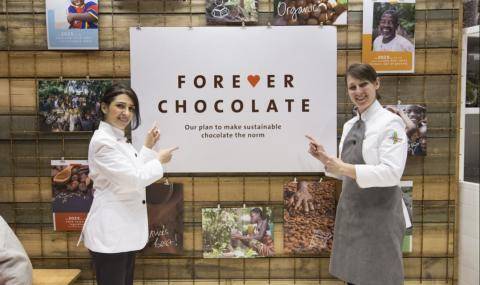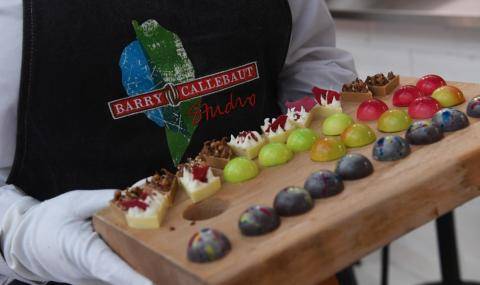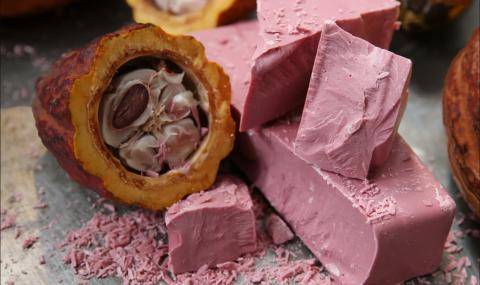Barry Callebaut Group – 3-Month Key Sales Figures, Fiscal Year 2017/18

Barry Callebaut Group – 3-Month Key Sales Figures, Fiscal Year 2017/18
- Sales volume up +8.0%, supported by all Regions and Product Groups
- All key growth drivers contributed to the Group outperforming the market1
- Sales revenue reached CHF 1,872.2 million, a slight decline of -0,7%, mainly impacted by lower cocoa prices and other lower raw material prices
- Mid-term guidance confirmed2
We had a strong start to the new fiscal year, with significantly above market growth. I am pleased to see that our increase in volume is broad-based, with positive contributions across all regions and good momentum amongst all key growth drivers.
Group Key Sales Figures
|
for the first 3 months of Fiscal Year 2017/18 |
|
|
|
3 months up to |
3 months up to |
|
|
|
Change in % |
|
|
|
|
|
|
in local currencies |
in CHF |
|
|
|
|
|||||
|
Sales volume |
Tonnes |
|
8.0% |
532,165 |
492,931 |
|
Sales revenue |
CHF m |
(3.2%) |
(0.7%) |
1,872.2 |
1,885.8 |
The Barry Callebaut Group, the world’s leading manufacturer of high-quality chocolate and cocoa products, achieved strong sales volume growth of +8.0% to 532,165 tonnes during the first three months of fiscal year 2017/18 (ended on November 30, 2017). During the same period, the global chocolate confectionery market grew +3.1%1. Volume growth was fueled by all Regions and Product Groups. All the key growth drivers contributed to the market outperformance, Gourmet & Specialties (+8.9%), Emerging Markets (+11.1%) and Outsourcing (+8.1%). Sales revenue for Barry Callebaut amounted to CHF 1,872.2 million, a slight decline of -0.7% in CHF (-3.2% in local currencies) versus prior year. This is mainly due to the impact of lower cocoa prices and other lower raw material prices, which, based on the company’s cost-plus model, are for the majority of its business passed on to customers.
Outlook:
Looking ahead, CEO Antoine de Saint-Affrique said: “We have good visibility on our sales portfolio and expect the market recovery to continue. This, along with the diligent execution of our ‘smart growth’ strategy, gives us the confidence that we are on track to deliver on our 2018/19 mid-term guidance2.”
Strategic milestones in the first three months of fiscal year 2017/18
Expansion: Barry Callebaut completed the acquisition of D'Orsogna Dolciaria in Italy, October 2017, and Gertrude Hawk Ingredients in the U.S., December 2017, further expanding Barry Callebaut’s value-adding Specialties & Decorations business. Furthermore, to keep serving its customers optimally, Barry Callebaut announced investments to increase its chocolate production capacity globally and in particular in Western Europe over the course of the coming year. In addition, Barry Callebaut is planning to build a global Center of Expertise for its Decorations business in Halle to co-develop decorations with customers and technologies with third parties.
Innovation: Barry Callebaut unveiled the fourth type of chocolate, Ruby chocolate, September 2017. Using a unique process, the company unlocked the intense new flavor and reddish color tone naturally present in Ruby cocoa beans. No berries, berry flavors or coloring are added. Japanese Kitkat was the first consumer brand in the world to launch, on January 19, a Ruby chocolate version. In addition, partnering with the start-up company Solo Gelato, Barry Callebaut announced its intention to launch a novel capsule system for instant-fresh ice cream. This product will be released on the global market in the second half of 2018.
Sustainability: December 2017, Barry Callebaut published its Forever Chocolate progress report 2016/17. The company worked globally with over 157,000 farmers on good agricultural practices. Approximately 36% of all cocoa and 30% of other chocolate ingredients were sustainably sourced in fiscal year 2016/17. Barry Callebaut has further developed its Farm Services program, which offers cocoa farmers products and services that help improve their productivity. In Ivory Coast, participating cocoa farmers experienced on average a productivity increase of +23% per hectare of farmland. November 2017, Barry Callebaut was one of the signatories of the landmark Cocoa and Forests Initiative’s Frameworks for Action, uniting governments, industry and NGOs to eradicate deforestation from cocoa production in Côte d’Ivoire and Ghana.
The full progress report can be accessed at: http://forever-chocolate.barry-callebaut.com/
Regional/Segment performance
Region EMEA – Strong performance supported by outsourcing
The European chocolate confectionery market volume grew +3.6%3
Barry Callebaut’s sales volume in Region EMEA (Europe, Middle East, Africa) recorded double-digit volume growth of +10.3% to 248,184 tonnes, driven by the strong performance of Food Manufacturers, supported by the further ramp-up of the Mondelēz agreement in Belgium, and a continued solid trend at Gourmet & Specialties in Western Europe. Eastern Europe is firmly back in double-digit growth territory thanks to a more diversified customer base, with both Food Manufacturers and Gourmet growing at a similar pace.
Sales revenue in Region EMEA increased by +8.0% in CHF (+2.0% in local currencies) and reached CHF 834.6 million. This was the result of good volume growth and a positive product mix, offset by lower cocoa prices and other lower raw material prices.
Region Americas – A good start to the new fiscal year
The chocolate confectionery market volumes in the Americas grew +1.3%3.
Region Americas had a good start with +2.9% volume growth to 136,981 tonnes, driven by solid results in Food Manufacturers and Gourmet.
In South America, Food Manufacturers reached double-digit growth mainly due to higher sales in Brazil.
Sales revenue in Region Americas was flat at -0.2% in CHF (-0.3% in local currencies) and amounted to CHF 430.8 million, as a result of lower cocoa and other lower raw material prices.
Asia Pacific – Continued double-digit growth
Chocolate confectionery market volumes in Asia Pacific grew by +4.8%4.
Barry Callebaut’s Region Asia Pacific delivered double-digit volume growth of +17.4% to 26,467 tonnes, growing both in Food Manufacturers and Gourmet. Growth was supported by the continued ramp-up of the Garuda Food outsourcing agreement in Indonesia, a strong Gourmet business and positive developments in India and China.
Sales revenue rose by +4.6% in CHF (+6.6% in local currencies) to CHF 97.2 million as a result of good volume growth, offset by lower cocoa and other lower raw material prices.
Global Cocoa – Market momentum continues
Global Cocoa volumes sold to third parties rose by +7.4% to 120,533 tonnes. The company experienced exceptionally strong market demand for cocoa products in the first quarter of 2017/18 due to a positive market environment and a reduction in suppliers.
Sales revenue declined by -13.4% CHF (-13.8% in local currencies) to CHF 509.6 million mainly due to lower cocoa powder and cocoa butter prices as a consequence of a drop in cocoa bean prices.
Price developments on the most important raw material spot markets
From September 2017 to November 2017, cocoa prices in London dropped modestly by -1.8%, from GBP 1,522 per tonne on August 31, 2017, closing at GBP 1,495 per tonne. For the first quarter of the fiscal year, the average cocoa bean price declined by -27.4% compared to the same period in the prior year. Fundamentally, favorable weather conditions improved the outlook for the main cocoa producing country Côte d'Ivoire. Although cocoa bean demand picked up in most of the regions due to lower prices, the 2017/18 season is likely to show a small surplus overall.
Sugar prices decreased in the first two months of the period under review before recovering in November 2017. In the EU, sugar prices decreased due to a record EU crop in combination with the new EU sugar regime, which scrapped production and export quotas. Global dairy production continued to increase, supported by higher milk prices, strong yields and low feed costs. This production surplus weighed on dairy prices.
1Source: Nielsen Chocolate confectionery sales in volume, August-October 2017
2Mid-term guidance: 4-6% volume growth, and EBIT above volume growth in local currencies on average, barring any major unforeseen events
3Source: Nielsen Chocolate confectionery sales in volume, August-October 2017
4Source: Nielsen Chocolate confectionery sales in volume, August-October 2017
***
|
Financial calendar for fiscal year 2017/18 (September 1, 2017 to August 31, 2018): |
|
|
Half-year results 2017/18 |
April 11, 2018 |
|
9-month key sales figures 2017/18 |
July 13, 2018 |
|
Full-year results 2017/18 |
November 07, 2018 |
|
Annual General Meeting 2017/18 |
December 12, 2018 |
***
About the Barry Callebaut group:
With annual sales of about CHF 6.8 billion (EUR 6.3 billion / USD 6.9 billion) in fiscal year 2016/17, the Zurich-based Barry Callebaut Group is the world’s leading manufacturer of high-quality chocolate and cocoa products – from sourcing and processing cocoa beans to producing the finest chocolates, including chocolate fillings, decorations and compounds. The Group runs close to 60 production facilities worldwide and employs a diverse and dedicated global workforce of about 11,000 people.
The Barry Callebaut Group serves the entire food industry, from industrial food manufacturers to artisanal and professional users of chocolate, such as chocolatiers, pastry chefs, bakers, hotels, restaurants or caterers. The two global brands catering to the specific needs of these Gourmet customers are Callebaut® and Cacao Barry®.
The Barry Callebaut Group is committed to make sustainable chocolate the norm by 2025 to help ensure future supplies of cocoa and improve farmer livelihoods. It supports the Cocoa Horizons Foundation in its goal to shape a sustainable cocoa and chocolate future.
|
Group Key Sales Figures |
|||||
|
for the first 3 months of Fiscal Year 2017/18 |
|
|
|
3 months up to |
3 months up to |
|
|
|
Change in % |
|
|
|
|
|
|
in local currencies |
in CHF |
|
|
|
|
|||||
|
Sales volume |
Tonnes |
|
8.0% |
532,165 |
492,931 |
|
Sales revenue |
CHF m |
(3.2%) |
(0.7%) |
1,872.2 |
1,885.8 |
|
By Region |
|||||
|
EMEA |
|
|
|
|
|
|
Sales volume |
Tonnes |
|
10.3% |
248,184 |
225,087 |
|
Sales revenue |
CHF m |
2.0% |
8.0% |
834.6 |
772.7 |
|
Americas |
|
|
|
|
|
|
Sales volume |
Tonnes |
|
2.9% |
136,981 |
133,112 |
|
Sales revenue |
CHF m |
(0.3%) |
(0.2%) |
430.8 |
431.7 |
|
Asia Pacific |
|
|
|
|
|
|
Sales volume |
Tonnes |
|
17.4% |
26,467 |
22,544 |
|
Sales revenue |
CHF m |
6.6% |
4.6% |
97.2 |
92.9 |
|
Global Cocoa |
|
|
|
|
|
|
Sales volume |
Tonnes |
|
7.4% |
120,533 |
112,188 |
|
Sales revenue |
CHF m |
(13.8%) |
(13.4%) |
509.6 |
588.5 |
|
By Product Group |
|
|
|
|
|
|
Sales volume |
Tonnes |
|
8.0% |
532,165 |
492,931 |
|
Cocoa Products |
Tonnes |
|
7.4% |
120,533 |
112,188 |
|
Food Manufacturers Products |
Tonnes |
|
8.0% |
346,843 |
321,233 |
|
Gourmet & Specialties Products |
Tonnes |
|
8.9% |
64,789 |
59,510 |
|
Sales revenue |
CHF m |
(3.2%) |
(0.7%) |
1,872.2 |
1,885.8 |
|
Cocoa Products |
CHF m |
(13.8%) |
(13.4%) |
509.6 |
588.5 |
|
Food Manufacturers Products |
CHF m |
1.1% |
4.5% |
1,047.6 |
1,002.8 |
|
Gourmet & Specialties Products |
CHF m |
1.8% |
7.0% |
315.0 |
294.5 |



